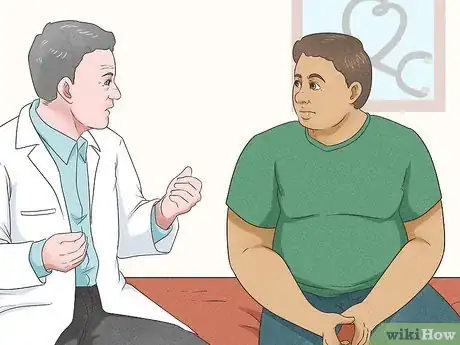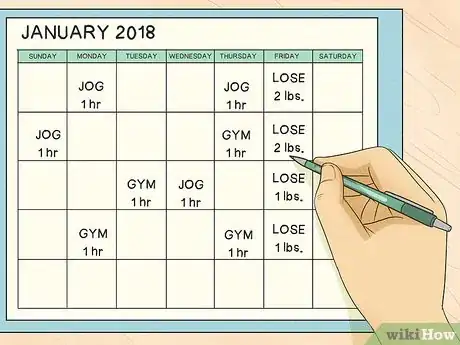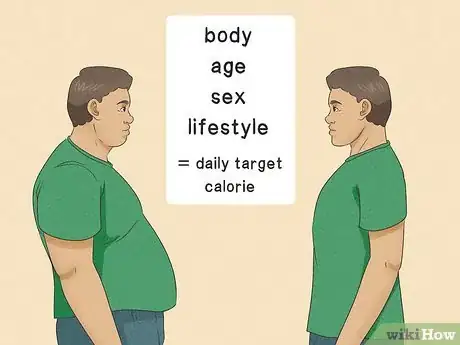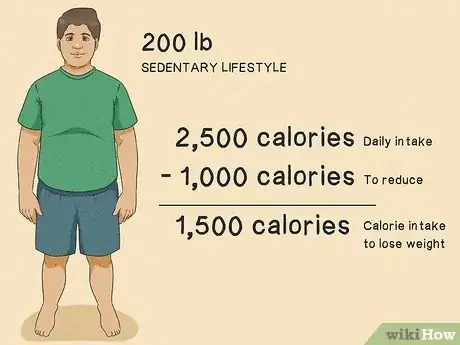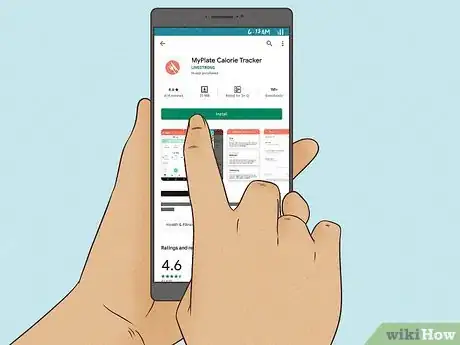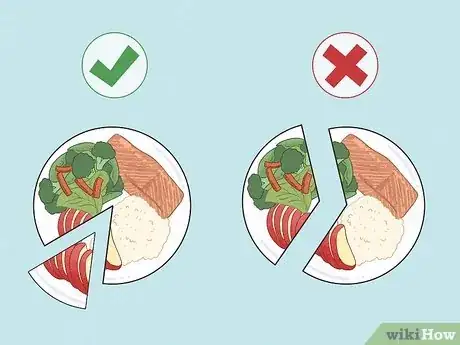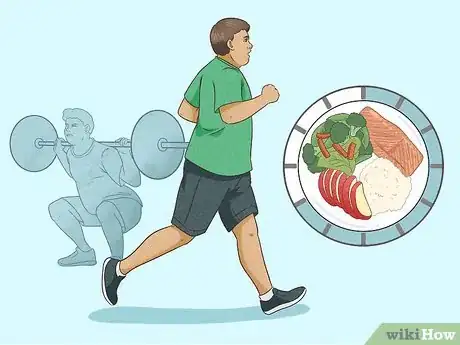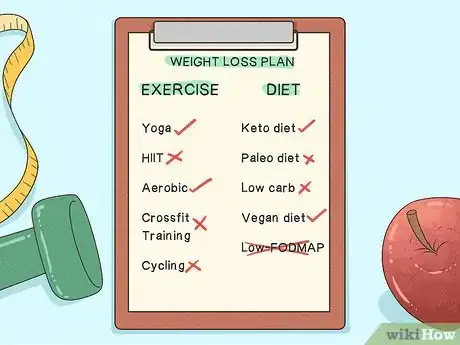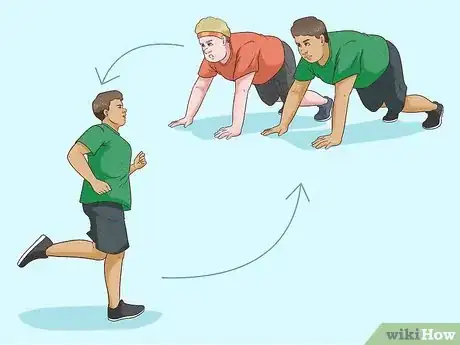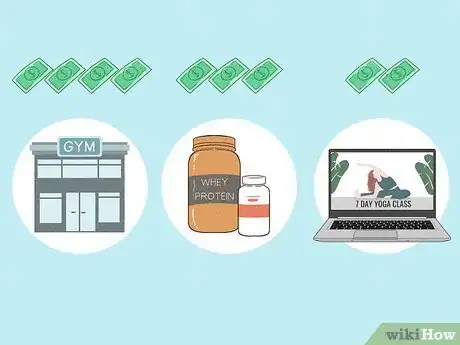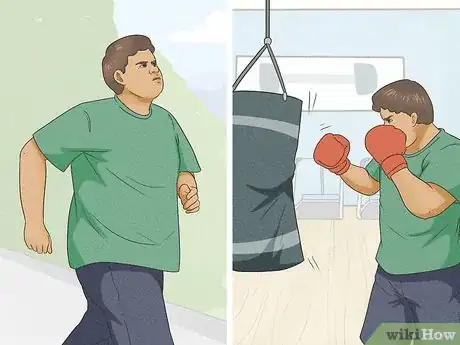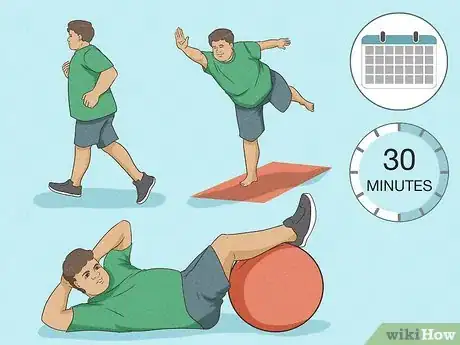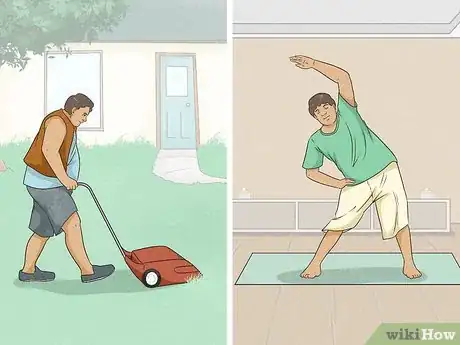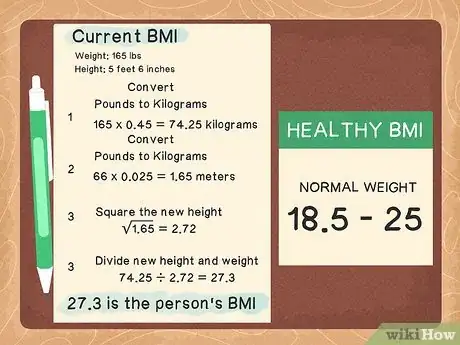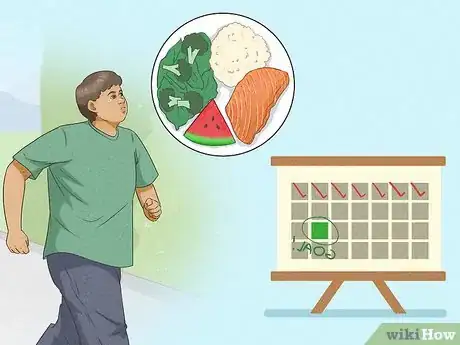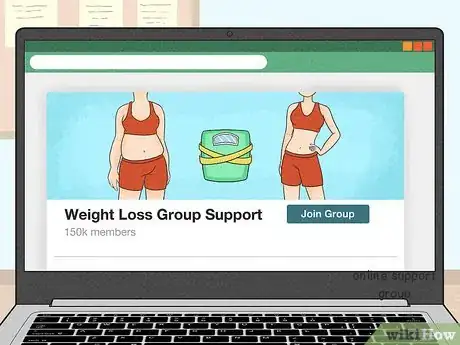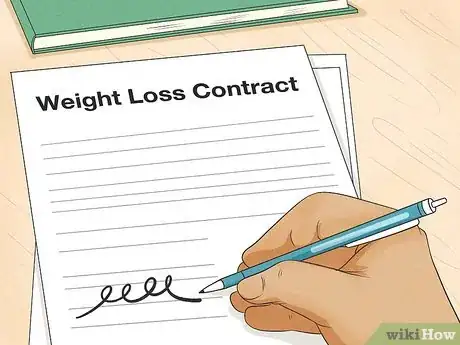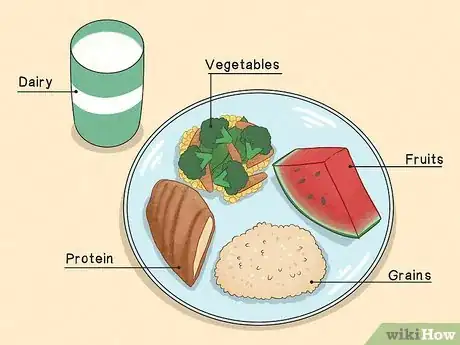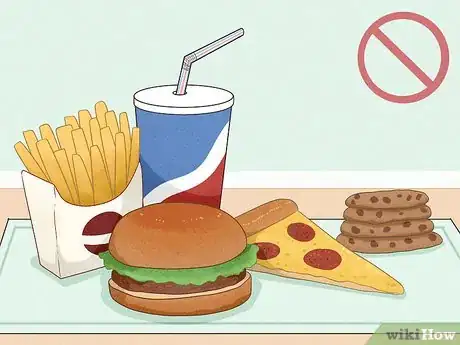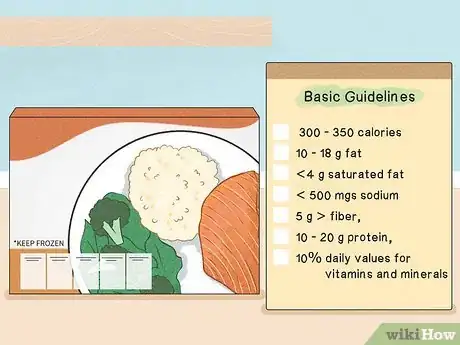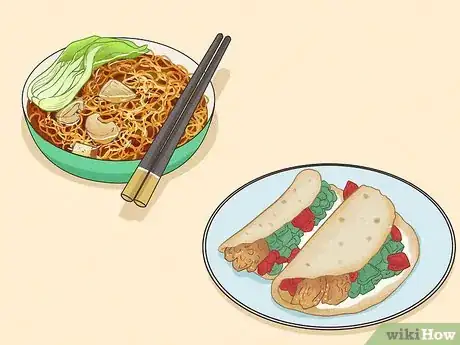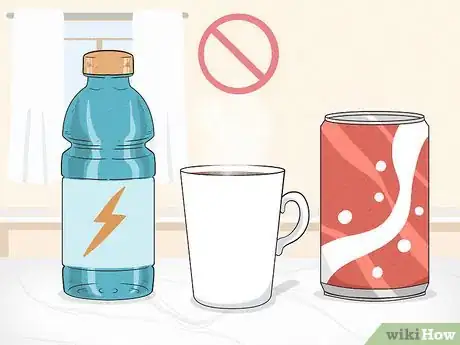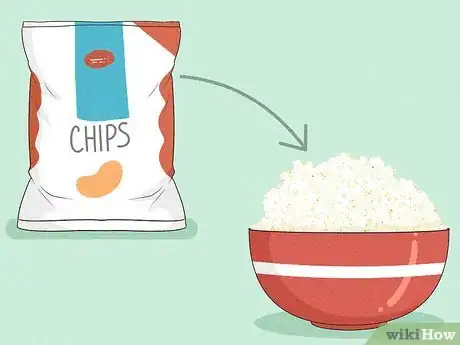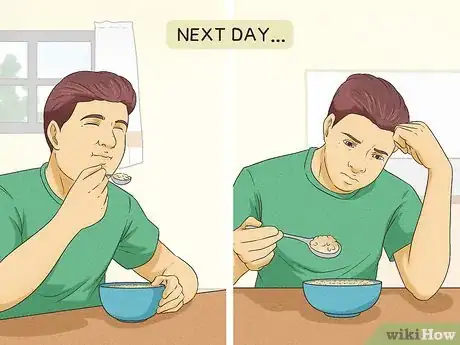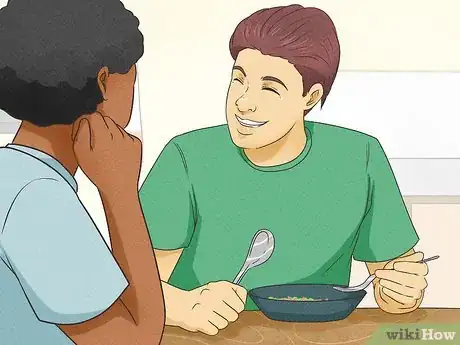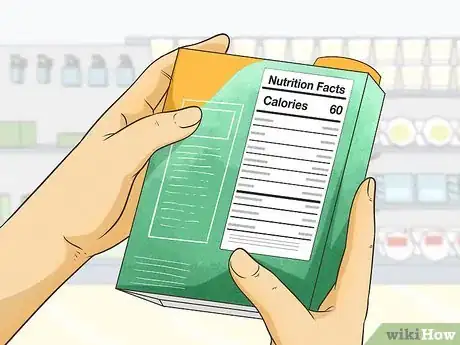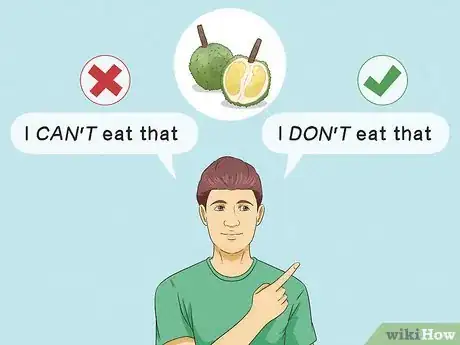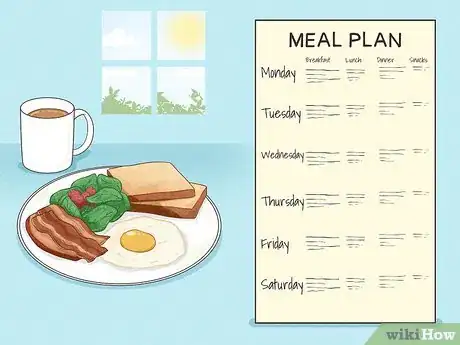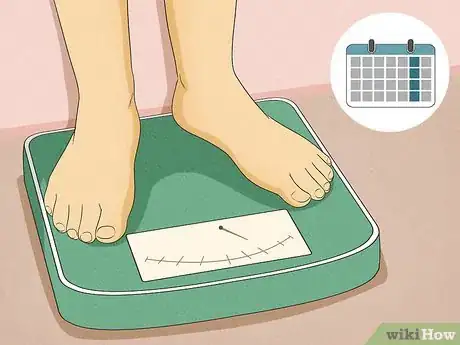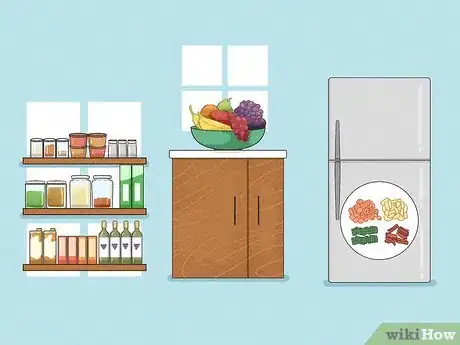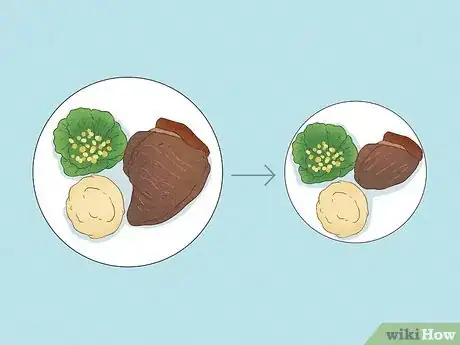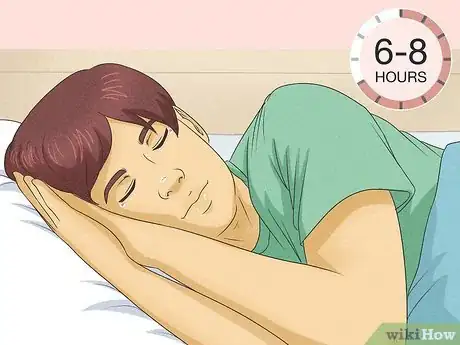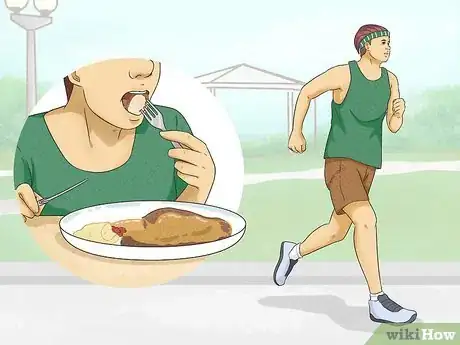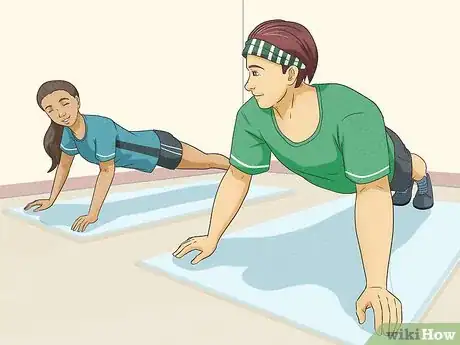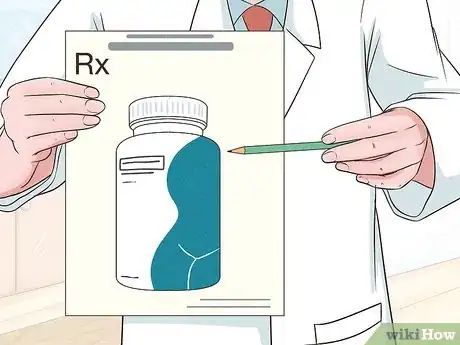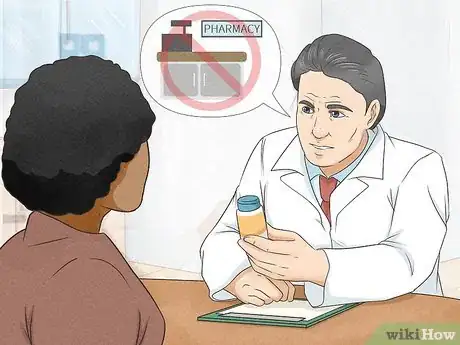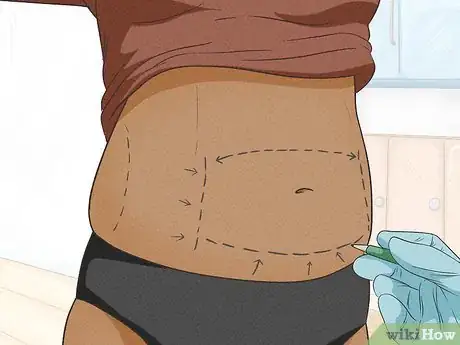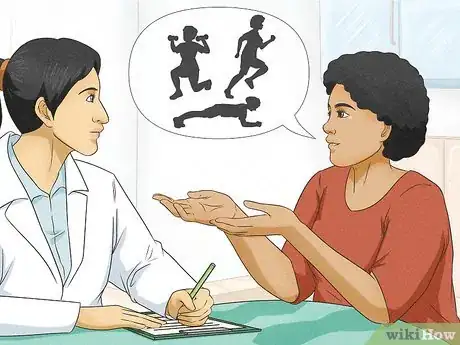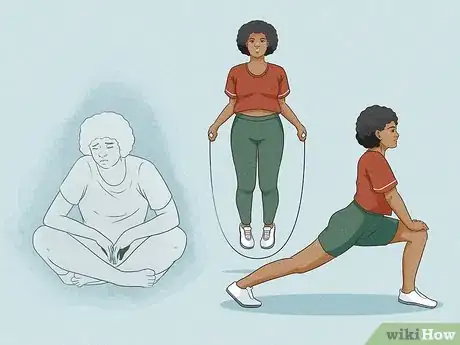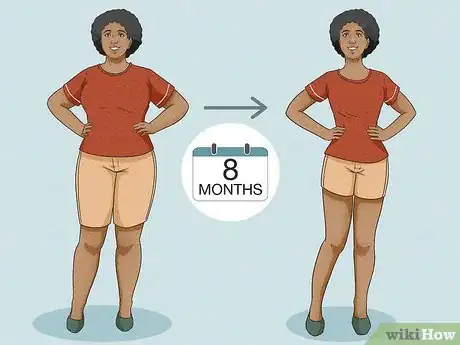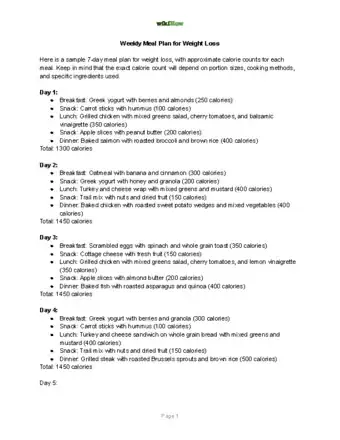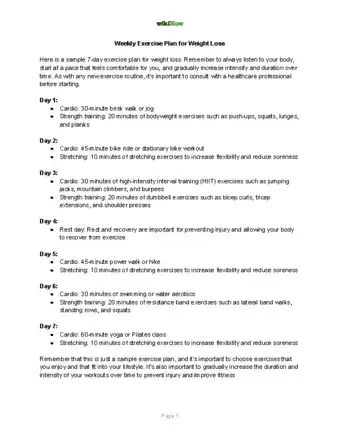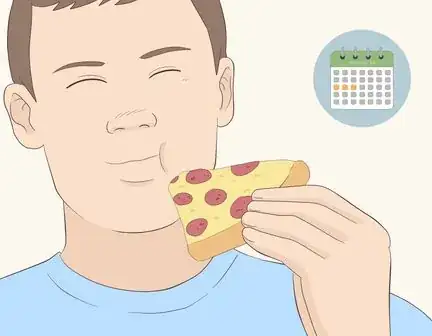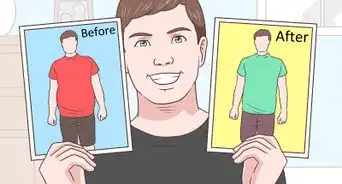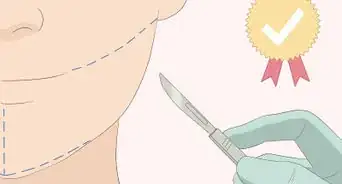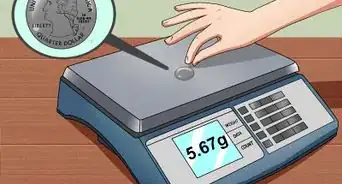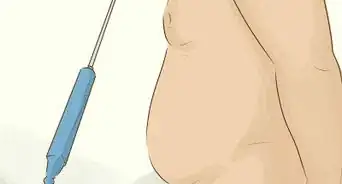This article was co-authored by Pouya Shafipour, MD, MS. Dr. Pouya Shafipour is a Family Medicine Specialist, Primary Care Physician, and a Weight Loss Specialist based in Santa Monica, California. Dr. Shafipour specializes in dietary, nutritional, behavioral, and exercise counseling to manage obesity and medical conditions related to excessive weight gain or loss. Dr. Shafipour received a BS in Molecular and Cell Biology from the University of California, Berkeley, an MS in Physiology and Biophysics from Georgetown University, and an MD from the Loma Linda University School of Medicine. He completed his internship in general surgery at UC Irvine and a residency in family medicine at the University of California, Los Angeles, and became board certified in family medicine in 2008.
There are 13 references cited in this article, which can be found at the bottom of the page.
wikiHow marks an article as reader-approved once it receives enough positive feedback. In this case, several readers have written to tell us that this article was helpful to them, earning it our reader-approved status.
This article has been viewed 809,953 times.
You don't have to starve yourself to lose weight; in fact, you shouldn't. Losing weight the healthy way involves a commitment to your plan and patience. Following guidelines for a healthy approach to weight loss is also key in maintaining your weight once you reach your target. Combining your weight loss plan with ways to control your metabolism can help you to reach your goal more quickly, and still lose your weight the healthy way.
Steps
Planning
-
1Talk to your doctor about weight loss. Be sure you need to lose weight, and that this is the best time for you to proceed with weight loss. If you are pregnant or have a medical condition, your body may need added calories to maintain your health, so this is not the time to start losing weight.[1]
- If you have medical conditions such as hypertension, diabetes, or cardiovascular problems, talk to your doctor before starting a diet and exercise plan.[2] Many factors, including age, current weight, and overall physical health, should be discussed with your doctor in order to safely start a diet and exercise plan.[3]
-
2Set reasonable and realistic goals. Weight loss of 0.5 to 2 pounds per week is a healthy approach. Allow yourself the time you need to reach your weight loss goal, planning on a loss of up to 2 lbs. each week.[4]
- While it may be tempting to pursue fad diets with promises of fast weight loss, a slow and steady approach is the healthiest way to lose weight.[5] It also provides ample time for your skin to adjust and helps you lose the weight without developing loose skin.
- While fad diets may help you drop weight quickly, they are not sustainable long term and once you stop the fad diet, you often gain back the weight plus more.
Advertisement -
3Incorporate your daily calorie target in your plan. Weight loss happens when you burn more calories than you consume. Your doctor can help determine the number of calories to consume each day specific to your body, age, sex, and lifestyle.
-
4Do the math. One pound is equal to about 3,500 calories. In order to lose 1 to 2 pounds each week, your daily calorie consumption needs to decrease by about 500 to 1000 calories, or your activity level needs to increase to burn more calories.[6]
- As an example, a moderately active 35-year-old female needs to consume about 2000 calories per day to maintain her current weight. A target goal of 1400 to 1600 calories per day will create a situation of weight loss for this person.
- Daily calorie goals factor in age, sex, and level of physical activity. Some medical conditions can be a factor that may also need to be considered.
-
5Download a food logging app onto your computer or phone and log everything you eat. This way you know your calories every day.
-
6Avoid setting your daily calorie goal too low. This can actually prevent you from losing weight. When you skip meals or consume too few calories, your body starts to store calories as fat instead of burning them.
-
7Come up with a plan that fits your own likes and dislikes. Many healthy weight loss plans already exist and can be tweaked to suit your own preferences and needs. Whether you tweak a formal diet plan or come up with your own, be sure it is suited to you and is a plan you can live with for a long time, not just for a few months.[7]
- For a successful healthy lifestyle change, it is important that your new plan fit into your life without too much difficulty. Adjusting how you eat and exercise is one thing, completely changing to foods you don't normally eat and exercises you don't enjoy will most likely not be successful long term.[8]
-
8Consider your past experience with weight loss plans. As you develop your plan, incorporate what worked, and leave out what did not work.[9]
-
9Build in some flexibility. Add your own personal preferences, and include flexibility in both your food and physical activity choices. Plus, consider your preference to diet all alone or if you prefer support from a friend or group.[10]
-
10Create a plan that fits your budget. Some diet programs involve added costs. The added expense may be from a gym membership, joining a specific group, purchasing specific food items like supplements or meals, or attending regular appointments or group meetings.[11]
-
11Increase your physical activity and make this a part of your plan. Consider expanding on activities you already enjoy, like walking, Zumba dancing, biking, or yoga. Establish a physical activity routine that you can live with, for the long run. An exercise routine that includes aerobic activity and muscle development is ideal, but just increasing your level of activity is a great place to start.[12]
-
12Set your activity goal. Work towards 150 minutes or more per week of moderate physical activity, or 75 minutes of more vigorous aerobic activity or exercise, spread evenly throughout the week.[13]
-
13Recognize the difference between physical activity and exercise. Physical activity includes the things you already do every day, such as walking, housework, yard work, and running around in the yard with the kids, grandkids, or the family pet. Exercise involves structured, scheduled, and repetitive forms of activity that you do regularly.[14]
- However, seeking to add additional physical activity (taking the stairs rather than the elevator, walking rather than driving, etc.) can be a great way to reach your goals.
-
14Calculate your current and target BMI. Your doctor can tell you what your body mass index, or BMI is. A healthy BMI range is between 18.5 and 25.[15] [16]
- The formula to calculate BMI is a little confusing, but if you want to calculate your BMI, then follow these steps. Your BMI is your weight in kilograms (not pounds) divided by your height (in meters) squared.[17]
- Here is an example. For someone that is 5 feet 6 inches tall and weighs 165 pounds, the formula reveals the BMI to be 27.3.[18]
- Convert the pounds into kilograms. Do this by multiplying the weight in pounds by 0.45. So 165 x 0.45 = 74.25. Next, convert the height to meters. 5 feet 6 inches is 66 inches. Multiply the 66 by 0.025 to get 1.65 meters. Then square that number by multiplying it against itself, so 1.65 x 1.65 = 2.72. Divide the new weight number by the new height number; 74.25 ÷ 2.72 = 27.3. This person’s BMI is 27.3.[19]
-
15Commit to your plan. Successful weight loss requires a commitment to yourself to stick with your plan for the long term.[20]
-
16Join an online support group.
-
17Create a written contract. Some people find it helpful to put your plan in writing. Include why you want to lose the weight, the plan itself, how much weight you want to lose, and your target date to reach your desired weight. Then sign it as if you are signing a contract.[21]
Food Guidelines
-
1Include items from each food group, for every meal, in your plan. The 5 food groups include fruits, vegetables, grains, protein, and dairy. Your plate should be halfway covered with green vegetables and fruits, and the other half with protein and grains. The best dairy products to include in your diet are fat-free (skim) and low-fat (less than 1% fat).[22]
- Good protein sources include lean meats, beans, and fish. Nuts, seeds, and eggs are also protein sources.[23]
- Try to consume 3 servings per day of dairy products. Try to avoid cream cheese, cream, and butter.[24]
- Choose mostly grain products made from whole-grain. Some examples include whole-wheat flour, oatmeal, and brown rice.[25] Avoid packaged oatmeal, which often contains a lot of sugar.
- Fruits and vegetables contain fewer calories than most foods and are great sources of nutrients, vitamins, and minerals. While fruits are a great choice, they do contain calories and sugars, so limit your daily intake to about 4 servings, which is about 2 cups.[26]
-
2Avoid empty calories. Solid fats and sugars add calories but no nutrients to the foods we eat. Examples of foods with empty calories include cakes, cookies, pastries, pizza, ice cream, sodas, sports drinks, fruit drinks, sausage, hot dogs, and bacon.[27]
-
3Choose healthy frozen prepared dinners. Clearly, preparing your meals with fresh ingredients is the best and healthiest way to go. But everyone has days when cooking meals from scratch just doesn’t fit into the schedule. Frozen dinners have evolved over time, and there are some healthy options out there.
- Follow these basic guidelines as you select frozen meals. Choose meals that include servings of lean meat, fish, or poultry, vegetables, and whole grains. Try to target meals that have 300 to 350 calories, 10 to 18 grams of total fat, less than 4 grams of saturated fat, less than 500 mgs of sodium, 5 grams or more of fiber, 10 to 20 grams of protein, and about 10% of the recommended daily values for vitamins and minerals.
-
4Check calories on food packaging. It's easier to watch calories and enjoy eating by buying pre-portioned food. 100 calories per bag popcorn, 110 calories per ice cream bar, even snacks in portioned bags allow you to monitor calories and reduce the urge to eat too much.
-
5Include cultural and ethnic foods in your plan. Specific cultural or ethnic preferences are a way of life for many people. Include your favorite, but healthy, cultural and ethnic food choices in your weight loss plan.[28]
-
6Drink plenty of water. While drinking a lot of water is a big part of some diet programs, others place less emphasis on the amount and just emphasize the importance of water intake for reasons of general health. Some experts report that drinking water when you are hungry helps you to feel full, and therefore controls that cue your stomach sends to your brain that you need to eat.[29]
-
7Avoid sugary drinks, sodas, energy drinks, and sport beverages. Beyond drinking plenty of water, include coffee and tea, minus the added sweeteners, as part of your plan. Limit your intake of diet drinks, milk other than skim, fruit juice, and alcohol.[30]
Lifestyle Changes
-
1Break your old food habits. Emotional or comfort eating gets in the way of nutritional eating. Think about healthy foods you like that can replace your past unhealthy comfort foods.[31]
- Look up healthy recipe swaps for your favorite dishes so you won't feel so restricted.
-
2Pay attention to how foods make you feel physically. Eating something fried might taste good today, but it might not feel so good the next morning.[32]
-
3Slow down as you eat. Your stomach will start to feel full if you slow down as you eat. Have a conversation with someone, or put the fork down between bites, to allow your stomach to tell your brain you are getting full.[33]
-
4Read the labels. Be aware of what you plan to eat, and read the nutrition labels to be sure you are eating what you planned.[34]
- Some packaging can be misleading for marketing purposes, so looking at the nutrition label is essential.
-
5Talk about food differently. Some foods are more pleasant than others, no doubt. Take control of experiencing new foods by removing the words “I can’t eat that”, and instead say “I don’t eat that”. By changing how you talk about food, it puts you in control of choosing foods you do not routinely eat.[35]
- Instead of talking about the foods you can no longer have, talk about all of the foods you are adding in like fruit, vegetables, lean proteins, etc. Shifting your mindset from restriction to addition can make a big difference.
-
6Practice healthier eating every day, and all day. Eat breakfast, plan ahead so you know what you will eat when you get hungry, avoid over-eating which can happen when watching TV, and eat the healthy food choices first. Other routines that can help include eating smaller meals, or snacks, throughout the day instead of 3 larger meals.[36]
-
7Weigh yourself once a week. The scale can help you to tweak your plan if you need to, and to stay on track with meeting your goal.[37]
-
8Set up your pantry and kitchen to help you. What you can see in your cabinet, or can easily reach for, may not always be the best choice. Keep fruit on the counter and chopped veggies in the fridge. Easy access to healthy choices can help avoid unhealthy snacking.[38]
-
9Reduce temptation. Get rid of the cookies and ice cream. Having the tempting foods within reach can pull you away from your plan.[39]
-
10Use smaller plate sizes. Smaller plates can help with portion control, decreasing the number of calories you consume at mealtime. Always eat off a plate as opposed to out of a box, bag, or carton.[40]
- You can pre-portion out servings of snack foods and leave them in your pantry to prevent overeating from the container. Grocery stores also have a lot of pre-portioned options.
-
11Get plenty of sleep. People that get enough sleep burn up to 5% more calories at rest than people that do not get a good night’s sleep. Plus, getting the sleep you need increases the amount of fat you lose compared to people that sleep less than 6 hours each night.[41]
-
12Get back on track after a setback. Life happens. Weddings, covered dish dinners, birthday parties, game-day snacks, or a night out on the town can all involve eating, or drinking, calories that are not in your plan.[42]
- Think about what you could have done differently, and plan ahead so you will be ready for those challenging events next time.[43]
- Avoid the "all or nothing" mentality. Just because you messed up once, doesn't mean you can spiral out of control and have anything else you want. It happened, move on and don't be so hard on yourself.
-
13Ask for help. Talking to your friends and family about your weight loss plan can help you stay focused on your goal. You may have a friend that will want to join you in losing weight. Support groups are also available that can provide encouragement, as well as personal tips on struggles they encounter.[44]
- Sharing your goals can also prevent others from being bad influences when know you are serious about losing weight.
Medical Options
-
1Take prescription weight loss medications. Talk to your doctor to determine if prescription drugs for weight loss are right for you. The FDA has recently approved several agents that can help with weight loss. Using prescription products will depend on your existing medication regimen, any medical conditions you may have, and the amount of weight you need to lose.
-
2Avoid products that are available over-the-counter, unless your doctor agrees. Over-the-counter weight loss products have not been studied and tested for efficacy the way prescription-only products have been. Your doctor may consider over-the-counter products for you, but it is important to discuss this with your doctor before you try this type of product.
-
3Consider forms of surgery. For some people, considering surgical options may be the safest and most effective way to reach his or her weight loss goal. Only your doctor can properly evaluate your condition and determine if these options are right for you.[45]
- Four procedures are commonly done to help people lose weight. This type of procedure is called bariatric surgery. Two primary functions are provided by the available procedures. [46]
- The 2 functions include restriction, which physically limits the amount of food the stomach can contain, and malabsorption, which shortens the small intestine to reduce the number of calories and nutrients the body absorbs.[47]
- The 4 commonly performed procedures are called roux-en-Y gastric bypass, laparoscopic adjustable gastric banding, sleeve gastrectomy, and duodenal switch with biliopancreatic diversion.[48]
-
4Talk to your doctor about your medications. Your doctor may be able to help you, even though you do not realize it. In some cases, you may be taking prescription medications that cause weight gain or increase your appetite. By talking to your doctor about your weight loss goals, some of your medications can possibly be changed, or the dose adjusted, to help you achieve your goal.[49]
-
5Discuss your exercise plan with your doctor. Depending on how much weight you need to lose, any existing medical conditions, and your age, your doctor can help to guide you in exercise and activity options that are safe for you. Healthcare professionals, like your doctor or a registered dietician, are great resources for information, guidance, and support.[50]
-
6Be kind to yourself. Don't beat yourself up if you overeat, take a breath and start fresh the next day. We didn't become overweight by overeating once in a while, overeating was a daily habit.
-
7Be patient. It takes about 8 months to change a habit and once you start feeling healthier and people start mentioning how great you look, you will know you are on the right track!
Exercise and Meal Plan for Weight Loss
Lose Weight the Right Way with this Expert Series
Expert Q&A
Did you know you can get expert answers for this article?
Unlock expert answers by supporting wikiHow
-
QuestionIs losing 5 lbs a week healthy?
 Laura FlinnLaura Flinn is a National Academy of Sports Medicine (NASM) Certified Personal Trainer, USA Olympic Weightlifting Sports Performance Coach and Certified Fitness Nutritionist, with an additional qualification as a TRX Suspension Trainer. Laura runs her own personal training program based in the San Francisco Bay Area and specializes in topics such as weight loss, muscle growth, cardiovascular training, and strength training.
Laura FlinnLaura Flinn is a National Academy of Sports Medicine (NASM) Certified Personal Trainer, USA Olympic Weightlifting Sports Performance Coach and Certified Fitness Nutritionist, with an additional qualification as a TRX Suspension Trainer. Laura runs her own personal training program based in the San Francisco Bay Area and specializes in topics such as weight loss, muscle growth, cardiovascular training, and strength training.
NASM Certified Personal Trainer It really depends on your body type and how much excess weight you have. For example, if someone has 75 pounds to lose, they will lose weight faster than someone who has 5-10 pounds to lose. Genetics also play a big role on how much and how fast someone can lose weight. For most people, 5 pounds of weight loss a week is a little much. It's much safer to comfortably lose 1-2 pounds every week.
It really depends on your body type and how much excess weight you have. For example, if someone has 75 pounds to lose, they will lose weight faster than someone who has 5-10 pounds to lose. Genetics also play a big role on how much and how fast someone can lose weight. For most people, 5 pounds of weight loss a week is a little much. It's much safer to comfortably lose 1-2 pounds every week. -
QuestionIs the keto diet any good?
 Pouya Shafipour, MD, MSDr. Pouya Shafipour is a Family Medicine Specialist, Primary Care Physician, and a Weight Loss Specialist based in Santa Monica, California. Dr. Shafipour specializes in dietary, nutritional, behavioral, and exercise counseling to manage obesity and medical conditions related to excessive weight gain or loss. Dr. Shafipour received a BS in Molecular and Cell Biology from the University of California, Berkeley, an MS in Physiology and Biophysics from Georgetown University, and an MD from the Loma Linda University School of Medicine. He completed his internship in general surgery at UC Irvine and a residency in family medicine at the University of California, Los Angeles, and became board certified in family medicine in 2008.
Pouya Shafipour, MD, MSDr. Pouya Shafipour is a Family Medicine Specialist, Primary Care Physician, and a Weight Loss Specialist based in Santa Monica, California. Dr. Shafipour specializes in dietary, nutritional, behavioral, and exercise counseling to manage obesity and medical conditions related to excessive weight gain or loss. Dr. Shafipour received a BS in Molecular and Cell Biology from the University of California, Berkeley, an MS in Physiology and Biophysics from Georgetown University, and an MD from the Loma Linda University School of Medicine. He completed his internship in general surgery at UC Irvine and a residency in family medicine at the University of California, Los Angeles, and became board certified in family medicine in 2008.
Weight Loss Specialist I'm not particularly fond of fad diets. There are no magic tricks when it comes to losing weight. It's also exceptionally difficult to make major changes where you completely change the way you eat without spinning out of control. If you're not used to eating nothing but proteins and veggies, you probably aren't going to stick with it.
I'm not particularly fond of fad diets. There are no magic tricks when it comes to losing weight. It's also exceptionally difficult to make major changes where you completely change the way you eat without spinning out of control. If you're not used to eating nothing but proteins and veggies, you probably aren't going to stick with it. -
QuestionIs it better to sprint or jog to lose weight?
 Michele DolanMichele Dolan is a BCRPA certified Personal Trainer in British Columbia. She has been a personal trainer and fitness instructor since 2002.
Michele DolanMichele Dolan is a BCRPA certified Personal Trainer in British Columbia. She has been a personal trainer and fitness instructor since 2002.
Certified Fitness Trainer
References
- ↑ http://www.mayoclinic.org/healthy-lifestyle/weight-loss/basics/weightloss-basics/hlv-20049483?p=1
- ↑ Pouya Shafipour, MD, MS. Board Certified Family Medicine Specialist. Expert Interview. 8 May 2020.
- ↑ http://www.mayoclinic.org/healthy-lifestyle/weight-loss/basics/weightloss-basics/hlv-20049483?p=1
- ↑ http://www.cdc.gov/healthyweight/losing_weight/getting_started.html
- ↑ http://www.mayoclinic.org/healthy-lifestyle/weight-loss/basics/weightloss-basics/hlv-20049483?p=1
- ↑ http://www.cdc.gov/HEALTHYWEIGHT/LOSING_WEIGHT/INDEX.HTML
- ↑ http://www.mayoclinic.org/healthy-lifestyle/weight-loss/basics/weightloss-basics/hlv-20049483?p=1
- ↑ Pouya Shafipour, MD, MS. Board Certified Family Medicine Specialist. Expert Interview. 8 May 2020.
- ↑ http://www.mayoclinic.org/healthy-lifestyle/weight-loss/basics/weightloss-basics/hlv-20049483?p=1
- ↑ http://www.mayoclinic.org/healthy-lifestyle/weight-loss/basics/weightloss-basics/hlv-20049483?p=1
- ↑ http://www.mayoclinic.org/healthy-lifestyle/weight-loss/basics/weightloss-basics/hlv-20049483?p=1
- ↑ http://www.mayoclinic.org/healthy-lifestyle/weight-loss/in-depth/weight-loss/art-20048466
- ↑ http://www.mayoclinic.org/healthy-lifestyle/weight-loss/in-depth/weight-loss/art-20048466
- ↑ http://www.mayoclinic.org/healthy-lifestyle/weight-loss/in-depth/weight-loss/art-20048466
- ↑ http://extoxnet.orst.edu/faqs/dietcancer/web2/twohowto.html
- ↑ http://www.nlm.nih.gov/medlineplus/ency/article/003101.htm
- ↑ http://extoxnet.orst.edu/faqs/dietcancer/web2/twohowto.html
- ↑ http://extoxnet.orst.edu/faqs/dietcancer/web2/twohowto.html
- ↑ http://extoxnet.orst.edu/faqs/dietcancer/web2/twohowto.html
- ↑ http://www.cdc.gov/healthyweight/losing_weight/getting_started.html
- ↑ http://www.cdc.gov/healthyweight/losing_weight/getting_started.html
- ↑ http://www.nlm.nih.gov/medlineplus/ency/patientinstructions/000330.htm
- ↑ http://www.nlm.nih.gov/medlineplus/ency/patientinstructions/000330.htm
- ↑ http://www.nlm.nih.gov/medlineplus/ency/patientinstructions/000330.htm
- ↑ http://www.nlm.nih.gov/medlineplus/ency/patientinstructions/000330.htm
- ↑ http://www.nlm.nih.gov/medlineplus/ency/patientinstructions/000330.htm
- ↑ Pouya Shafipour, MD, MS. Board Certified Family Medicine Specialist. Expert Interview. 8 May 2020.
- ↑ http://www.mayoclinic.org/healthy-lifestyle/weight-loss/basics/weightloss-basics/hlv-20049483?p=1
- ↑ http://www.womenshealthmag.com/weight-loss/does-drinking-water-help-you-lose-weight
- ↑ http://www.hsph.harvard.edu/nutritionsource/healthy-drinks/
- ↑ http://www.nlm.nih.gov/medlineplus/ency/patientinstructions/000733.htm
- ↑ http://www.nlm.nih.gov/medlineplus/ency/patientinstructions/000733.htm
- ↑ http://www.nlm.nih.gov/medlineplus/ency/patientinstructions/000733.htm
- ↑ http://www.nlm.nih.gov/medlineplus/ency/patientinstructions/000733.htm
- ↑ http://www.nlm.nih.gov/medlineplus/ency/patientinstructions/000733.htm
- ↑ http://www.nlm.nih.gov/medlineplus/ency/patientinstructions/000733.htm
- ↑ http://www.nlm.nih.gov/medlineplus/ency/patientinstructions/000733.htm
- ↑ http://www.nlm.nih.gov/medlineplus/ency/patientinstructions/000733.htm
- ↑ http://www.nlm.nih.gov/medlineplus/ency/patientinstructions/000733.htm
- ↑ http://www.nlm.nih.gov/medlineplus/ency/patientinstructions/000733.htm
- ↑ http://www.womenshealthmag.com/weight-loss/sleep-weight-loss
- ↑ http://www.cdc.gov/healthyweight/losing_weight/getting_started.html
- ↑ http://www.cdc.gov/healthyweight/losing_weight/getting_started.html
- ↑ http://www.nlm.nih.gov/medlineplus/ency/patientinstructions/000733.htm
- ↑ http://www.mayoclinic.org/tests-procedures/bariatric-surgery/in-depth/weight-loss-surgery/art-20045334
- ↑ http://www.mayoclinic.org/tests-procedures/bariatric-surgery/in-depth/weight-loss-surgery/art-20045334
- ↑ http://www.mayoclinic.org/tests-procedures/bariatric-surgery/in-depth/weight-loss-surgery/art-20045334
- ↑ http://www.mayoclinic.org/tests-procedures/bariatric-surgery/in-depth/weight-loss-surgery/art-20045334
- ↑ Pouya Shafipour, MD, MS. Board Certified Family Medicine Specialist. Expert Interview. 8 May 2020.
- ↑ http://www.mayoclinic.org/healthy-lifestyle/weight-loss/in-depth/weight-loss/art-20048466
About This Article
To lose weight the healthy way, eat a balanced diet consisting of foods like vegetables, fruits, whole grains, and low fat dairy. Additionally, avoid sugary, processed foods such as cakes, soda, and sports drinks, which are high in calories with no nutritional value. Along with a healthy diet, increase the level of physical activities you already enjoy, like walking, biking, or yoga. You can also try adding other forms of physical activity, such as taking the stairs instead of the elevator or walking instead of driving whenever possible. For more advice from our Health reviewer, including how to set realistic and reasonable weight loss goals, keep reading!
